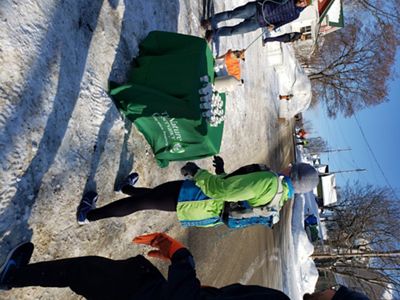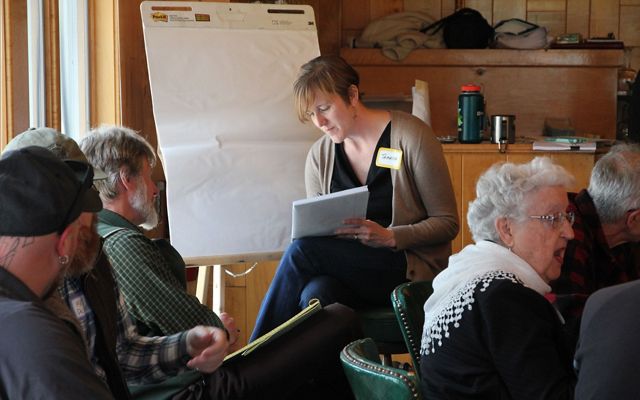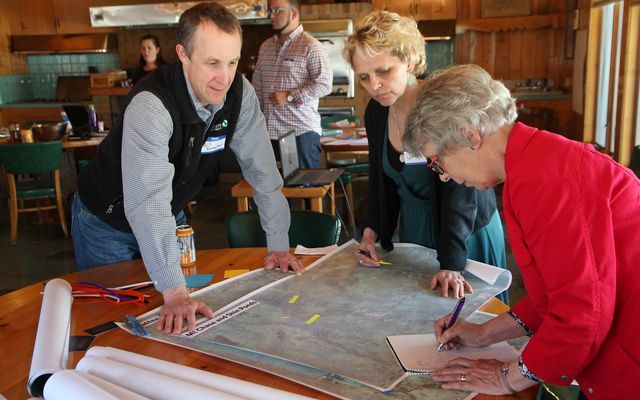Part of the Community
We're working with partners in the Katahdin region to make a difference for people and nature.
On a bright, cold early December day, Chris Stone stands in front of his Millinocket home offering encouragement as knots of people dressed in an unusual mix of spandex and wool run past. Chris is The Nature Conservancy in Maine's conservation forester, and he's set up a table full of "St. John Syrup Shots"—small paper cups of maple syrup made from sap tapped in the St. John River Forest Chris helps to manage. And the people running by over the frozen ground? They're participating in the fifth-annual Millinocket Marathon & Half, an event that takes runners through town and along the Golden Road, once the main artery between the working forest and the paper mills that thrived here.

In recent decades, with changes in technology and global trade, the region, once populated with bustling communities surrounding a robust timber industry, has seen a shift in economic fortunes. Paper mills have shut down and the forests no longer provide for the communities in the way they once did.
But people in the Katahdin region, from Millinocket to Island Falls, have been rolling up their sleeves and exploring new ways to value their resources and diversify the local economy. As a significant landowner in the region, The Nature Conservancy is a strong supporter of and participant in the process.
The Katahdin Collaborative: Working Together
In 2015, with the encouragement of local leaders, representatives of local groups, including TNC, formed the Katahdin Collaborative. The collaborative’s mission is to create a positive environment to facilitate communication, leverage resources, and foster collaboration among volunteer groups, businesses, non-profit institutions and municipalities working toward the revitalization of the Katahdin region. The group includes more than twenty long-standing and emerging groups, from the Katahdin Area Chamber of Commerce to local snow mobile clubs.
“The people living here are acting to ensure a better future for themselves, their children and grandchildren,” says Tamara Lee Pinard, TNC’s community initiatives manager. “Our role is to support the hard work it takes and provide a voice for long-term sustainability of this remarkable forest.”
Lee Pinard and Bill Patterson, senior field representative for northern Maine, have been spearheading TNC’s effort by supporting the Katahdin Collaborative in a constructive process to develop a unified vision for the region’s future.


This process has given a voice to community members and provided the region with tools to keep what is important and affect change where needed. It is an innovative, grassroots approach that captures what people in the Katahdin region value and translates those values into local action.
In May 2019, the effort achieved a milestone with the publication of the Katahdin Gazetteer: A Roadmap to the Future—Vision & Action Plan. The Gazetteer is a published document that lays out a shared vision for the future of the region and recognizes conserved natural resources as significant assets that enhance the cultural and economic fortunes of the area. Work is now underway to act on the many recommendations within the Gazetteer.
Supporting Outdoor Recreation
Developing more recreational opportunities and access is an important element outlined in this vision. To that end, Patterson, along with TNC Land Steward Robbie Smith, has been hard at work to enhance the visitor experience at TNC’s Debsconeag Lakes Wilderness Area. This 46,000-acre natural gem, located just south of Baxter State Park, contains the highest concentration of remote ponds in New England, and thousands of acres of mature forest.
Visitors enjoy canoeing, primitive backcountry camping and hiking—including on one of the most remote sections of the Appalachian Trail, which winds through the center of the preserve. Traditional pursuits such as fishing, hunting and snowmobiling are also popular there. And the Ice Caves Trail is one of the region's most traveled routes, attracting hikers from all over New England and beyond.

In 2017, TNC, with the help of an energetic crew from the Maine Conservation Corps, opened the Rainbow Loop Trail, a 5-mile circle featuring rocky ledges and spectacular views of Mount Katahdin. Signs throughout the preserve have also been updated, making it easier to identify lakefront campsites and portage trails from a distance. And a new trail and observation tower at TNC's nearby Trout Mountain property are scheduled to open in the summer of 2020.
“We see a strong commitment to traditional outdoor recreation in the area and opportunities to promote expanded use by locals and visitors alike,” says Patterson.
Back at the race, Chris stone urges many of those visitors on as they near the finish line. He's pleased to see the town bustling, lodgings filled to capacity and local businesses enjoying a busy weekend.
“It's just great to be part of the community," Stone says. "Despite the challenges people face in the region each day, you can feel positive momentum building. Really good things are happening in the heart of Maine.”


